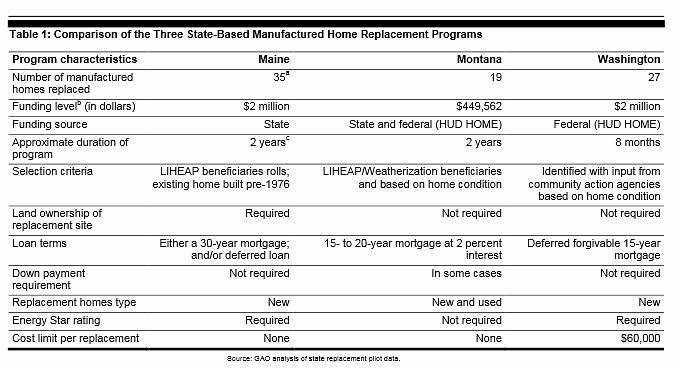March 29, 2013 — A new report by the Government Accountability Office (GAO) found that replacing older manufactured homes with newer ones doesn't save enough energy to offset the associated costs during a typical loan period.
Released in late March, the report examined pilot replacement programs in Maine, Montana, and Washington. The three states funded the programs using a combination of federal and state monies. In all, the states replaced 81 homes and spent $4.5 million over a two-year period. The cost effectiveness of replacing older units is relevant because there are two million of them in the country, and weatherization officials say many of them cannot be weatherized.
Before 1976, few regulations existed regarding the quality of manufactured homes. For instance, they had little or no insulation, thin walls, doors/windows that didn't seal properly, and other energy-efficiency problems. A 2012 GAO report found occupants of these homes paid more than twice as much for energy per square foot than people living in other types of housing. Not surprisingly, LIHEAP provided more assistance per square foot to people living in manufactured homes.
The states' pilot programs differed in their requirements for participants, the financing used, and the types of replacement units. The report found that, on average, the programs spent $56,119 per unit and estimated about $489 in annual energy savings. This wasn't alarming to the officials running the pilots, because the programs prioritized the health and welfare of occupants, while energy efficiency was secondary.
The GAO reported in 2012 that 3 percent of all LIHEAP funds ($57 million) were spent on providing energy assistance to occupants of older manufactured homes. The current GAO report determined the state pilots didn't decrease the need for LIHEAP; however they weren't designed with that in mind. State officials reported that many of the people receiving replacement homes still met LIHEAP's income eligibility requirements. In many cases, the newer manufactured homes were larger, and pilot participants may have experienced more debt due to loans associated with the programs.
LIHEAP funds cannot be used for replacement programs. Instead, all three states supported their pilot programs with funding from Department of Housing and Urban Development HOME and/or state money. Two of the states did use information provided by LIHEAP and weatherization agencies to identify potential pilot participants.
Of the three pilots, Maine is the only state still running a replacement program.

Source: Government Accountability Office


